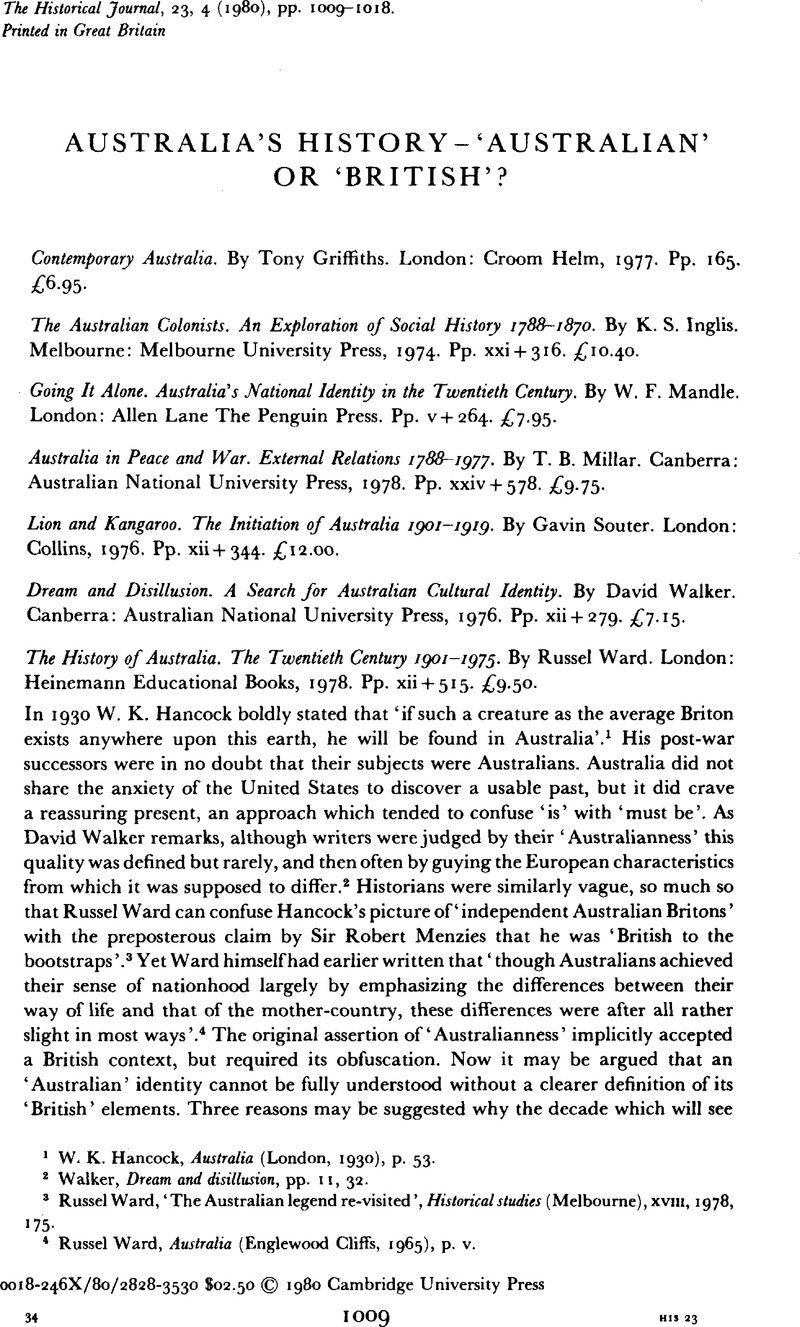No CrossRef data available.
Article contents
Australia's History – ‘Australian’ or ‘British’?
Published online by Cambridge University Press: 11 February 2009
Abstract

- Type
- Review Articles
- Information
- Copyright
- Copyright © Cambridge University Press 1980
References
1 Hancock, W. K., Australia (London, 1930), p. 53Google Scholar.
2 Walker, , Dream and disillusion, pp. II, 32Google Scholar.
3 Ward, Russel, ‘The Australian legend re-visited’, Historical studies (Melbourne), XVIII, 1978, 175Google Scholar.
4 Ward, Russel, Australia (Englewood Cliffs, 1965), p. vGoogle Scholar.
5 Pocock, J. G. A., ‘British history: a plea for a new subject’, Journal of Modern History, XLVU (1975), 601–28CrossRefGoogle Scholar.
6 Ward, Russell, The Australian legend (Oxford, 1958)Google Scholar, ch. 3.
7 Inglis, , The Australian colonists, pp. 39–42, 149, 27Google Scholar.
8 Ward, , History of Australia, pp. 51–2Google Scholar.
9 Souter, , Lion and kangaroo, pp. 147, 155, 111Google Scholar; Inglis, , The Australian colonists, pp. 274–7Google Scholar.
10 Ward, , History of Australia, pp. 195, 326, 387Google Scholar.
11 Ibid. p. 182. Cf. Radi, Heather and Spearritt, Peter (eds.), Jack Lang (Sydney, 1977)Google Scholar.
12 Walker, , Dream and disillusion, pp. 18, 101, 21, 166, 29, 174–6, 26, 105, 158Google Scholar; Souter, , Lion and kangaroo, p. 294Google Scholar. Ward, , History of Australia, p. 332Google Scholar, has a cartoon attacking Australian censorship drawn in 1966 by William Rushton, a quintessential Pom.
13 Mandle, Going it alone, ch. 7.
14 Inglis, , The Australian colonists, pp. 14–18, 37–9, 250Google Scholar.
15 Ibid. pp. 39, 127–9.
16 Inglis, K. S., ‘Imperial cricket: test matches between Australia and England, 1877–1900’ in Cashman, Richard and McKernan, Michael (eds.), Sport in history: the making of modern sporting history (St Lucia, Qld, 1979), pp. 148–79Google Scholar.
17 Walker, , Dream and disillusion, p. 35Google Scholar; Souter, Lion and kangaroo, ch. 3.
18 Ritchie, John, Australia as once we were (Mclbourne, 1975), ch. 11Google Scholar; Stoddart, Brian, ‘Cricket's imperial crisis: the 1932–33 MCC tour of Australia’ in Cashman, and McKernan, (eds.), Sport in history, pp. 124–47Google Scholar.
19 Ward, , History of Australia, pp. 191–2Google Scholar. Woodfull's admirers deny the tale.
20 Inglis, , The Australian colonists, pp. 41–2Google Scholar; Oakes, L., Whitlam PM: a biography (Sydney, 1973), P. IGoogle Scholar.
21 Inglis, , The Australian colonists, p. 28Google Scholar; Ward, , History of Australia, p. 174Google Scholar.
22 Inglis, , The Australian colonists, pp. 178–81, 191–206, 88–90, 94–104Google Scholar.
23 Souter, , Lion and kangaroo, p. 114Google Scholar.
24 Ward, , History of Australia, pp. 111–23Google Scholar.
25 Walker, , Dream and disillusion, p. 69Google Scholar.
26 Mandle, , Going it alone, p. 1Google Scholar.
27 Inglis, , The Australian colonists, pp. 93, 159–60, 253–63Google Scholar. Proximity may equally well have fostered understanding. Cf. Fitzhardinge, L. F. (ed.), Tales and legends of the Canberra pioneers (Canberra, 1967), pp. 58, 79–80Google Scholar.
28 Ned Kelly's Jerilderie letter is in Brown, Max, Ausralian son: the story of Ned Kelly (Melbourne, 1949), pp. 271–82Google Scholar.
29 Norris, R., The emergent Commonwealth. Australian Federation: expectations and fulfilment 1889–1910 (Melbourne, 1975)Google Scholar; Connolly, C. N., ‘Class, birthplace, loyalty: Australian attitudes to the Boer war’, Historical Studies (Melbourne), XVIII (1978), 210–32CrossRefGoogle Scholar. The best analysis of the modern period is by Hudson, W. J., ‘1951–72’ in Crowley, F. K. (ed.), A new history of Australia (Melbourne, 1974), pp. 504–51Google Scholar.
30 Mandle, Going it alone, ch. 6; Millar, , Australia in peace and war, pp. 227–36, 311–13Google Scholar.
31 In 1960 the Sydney Bulletin dropped its motto ‘Australia for the White Man’, having much earlier abandoned its corollary ‘China for the Chows’. Home, Donald, The lucky country: Australia in the sixties (Harmondsworth, 1964), p. 110Google Scholar. Cf. Millar, , Australia in peace and war, pp. 382–5Google Scholar; Ward, , History of Australia, pp. 318, 401Google Scholar.
32 Ward, , History of Australia, p. 360Google Scholar.
33 Ibid., p. 145; Oakes, , Whitlam PM, pp. 44–6Google Scholar.
34 Griffiths, , Contemporary Australia, pp. 114–20Google Scholar, argues that ‘it was personal grievances which shattered the Liberal Party’ and that offshore sovereignty was a ‘technical issue’. Ward, , History of Australia, pp. 378–91Google Scholar, argues that Gordon's casting vote against himself in a party room no confidence debate showed a ‘grace very unusual in polities’. There are however indications that Gorton had been warned that enough Liberal backbenchers would cross the floor to vote with Labor to destroy his House majority of Oakes, seven. L. and Solomon, D., The making of an Australian prime minister (Melbourne, 1973), p. 41Google Scholar.
35 Whitlam, Gough, The truth of the matter (Harmondsworth, 1979), p. 11Google Scholar.
36 Millar, , Australia in peace and war, pp. 397–402Google Scholar.




